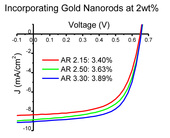Highlight
Plasmonic Nanoparticle Synthesis, Functionalization, and Integration into Organic Photovoltaic Solar Cell Active Layers for Efficiency Enhancement
Achievement/Results
Robert Wadams, a PhD student in the Materials Science and Engineering Department at Rutgers University and a trainee in the Nanotechnology for Clean Energy IGERT has been reporting ground-breaking research on the incorporation of plasmonic nanoparticles in organic photovoltaic solar cells, a means of enhancing photon to electric current conversion efficiency. He proposes that It is proposed that plasmonic nanoparticles have the potential to enhance solar cell efficiency through increasing the path-length of light within the active layer through scattering, therefore increasing the probability of photon absorption and subsequent charge generation. In order to study the effects of nanoparticle incorporation into organic photovoltaics, one must be able to tune the plasmon resonance frequency throughout the visible spectrum. Ideally, one would test nanoparticles having resonances with varying degrees of overlap with the active layer absorption spectrum. Gold nanorods provide this ability due to their aspect ratio dependent longitudinal plasmon resonance frequency, which can be tuned through bottom-up synthetic methods. However, it is imperative that the gold nanorod growth mechanism be understood in order to precisely tune the nanoparticle’s optical response.
Wadams, a student in Prof. Laura Fabris’ group, has developed a heuristic model of seed-mediated gold nanorod growth, that shows early growth is dominated by epitaxial micellar adsorption onto the developing crystalline facets of the seed (Figure 1). Epitaxial passivation is the driving force for anisotropic growth and ultimately determines the final morphology of the nanorod. Understanding the gold nanorod growth mechanism has led to recent developments in tuning nanorod aspect ratio. Wadams and his group have applied these developments toward incorporating nanorods into organic photovoltaics employing poly(3-hexylthiophene): Phenyl-C61- butyric acid methyl ester bulk-heterojunction active layers. They show marked improvements in device performance with nanorod incorporation. In fact, higher enhancements are seen using nanorods with having extinction spectra with the least degree of overlap with the active layer’s absorption spectra. Currently, Wadams and his collaborators at the Air Force Research Laboratory are working toward determining the specific enhancement mechanisms (Figure 2).
Address Goals
The use of surface plasmon resonance effect has been pointed to as the cause for device performance improvements in organic solar cells and organic light emitting diodes containing gold and/or silver nanoparticles. However, conclusive proof that the improved device performance is due to SPR rather than other spurious effects is presently lacking. The work of the IGERT trainee Rob Wadama and advisor Prof. Fabris, provides substantial insight into what leads to the enhancement in efficiency in organic solar cell devices containing gold nanorods. This insight has the potential to be transformative for the plasmonics as well as the organic electronic communities. The characterization of local atomic structure of soft materials has led to the development of new Raman and TEM analysis methdology.







